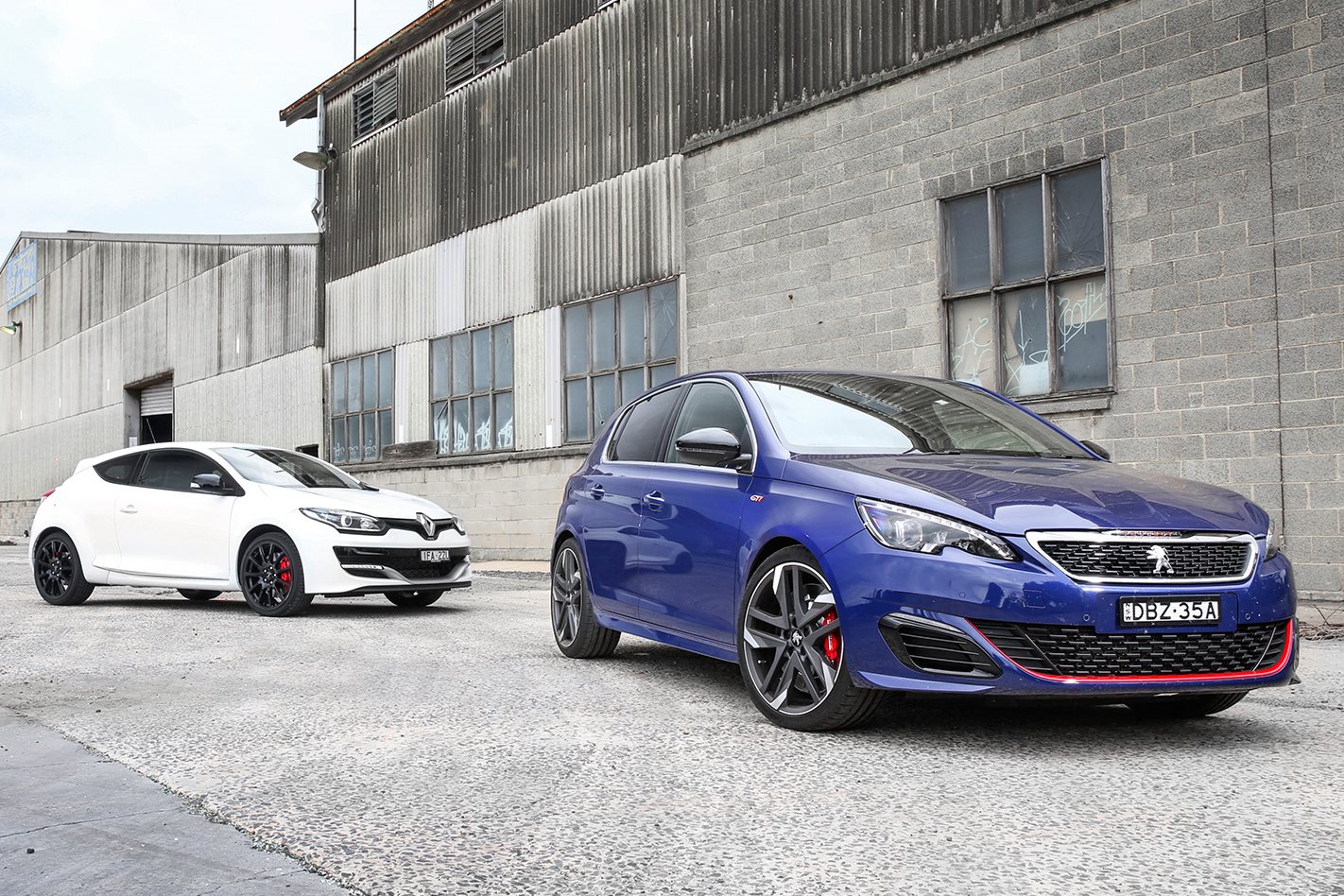A weapon’s potency can only be properly determined once it’s clear what it’s up against.
After all, Attila the Hun conquered most of Europe with swords, bows and arrows, but would’ve been badly outmatched in Desert Storm. So while Peugeot Sport has opened the bomb doors and delivered a pair of potent hot hatches, it’s our job to determine where the new 308 GTi stands in the pecking order.
For that we sent the juiciest 308, the $49,990 GTi 270, which scores more power and all sorts of go-fast goodies over its more basic GTi 250 sibling, out into the pen and waited for the predators to appear. Sadly, the pack is a little thinner Down Under than in its native Europe; the Seat Leon Cupra 290 isn’t sold here, Honda’s Civic Type R missed the boat and the Ford Focus RS is still on it (and is too all-wheel drive).
Possibly the Pug’s most obvious rival is the Volkswagen Golf GTI Performance, however sadly there wasn’t one available at the time of testing, which makes this tussle an all-French affair. That leaves only one hurdle for the 308 GTi to clear, but it’s an almighty big one.
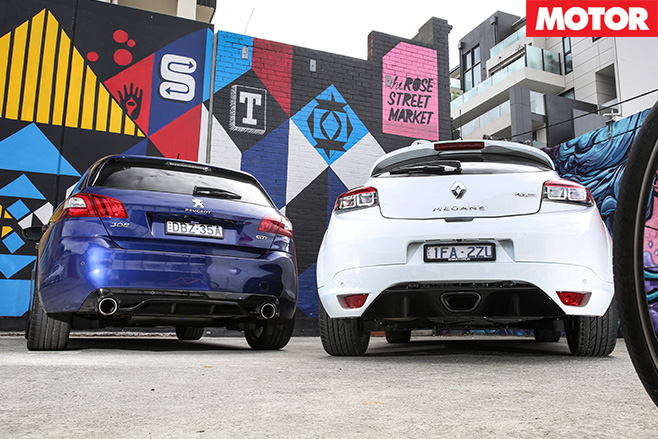
At $53,000, it’s $3K more with two less doors than the Peugeot, but if this pair were LEGO sets, you could build both with a similar set of blocks. Both use force-fed four-bangers backed by a six-speed manual gearbox, steer with electrical assistance and have a limited-slip differential stuffed between the front wheels.
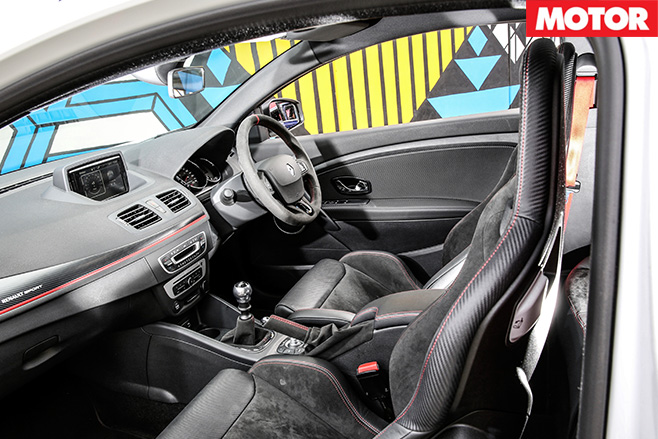
Climb inside, however, and it’s obvious which car is more open about its performance bent. Swathes of Alcantara coat the Renault’s interior, from the deeply-bolstered Recaros to the touch points on the steering wheel, handbrake and gear shift surround. The suede-like material also covers the rear bench and there’s a ‘Zamac’ alloy gear knob pinched from the limited-edition RS275 Trophy.
Familiar to those upgrading from the cheaper RS265 will be the bright red seatbelts that make you feel like you’re wearing a beauty pageant sash and carbon fibre inserts that sweep across the dashboard, as well as the curiously French ergonomics including the heavily sloped instrument display and random scattering of major functions: the cruise control/speed limiter button is between the seats, the audio controls are hidden by the steering wheel – you get the picture.
The Renault doesn’t have a monopoly on weirdo ergonomics, though. Thickly padded and coated in Alcantara and a plastic-coated fabric called TEP, the GTi 270-specific seats make the Megane’s feel like deck chairs, but the high hip point forces you into an awkward driving position, requiring the tiny steering wheel be dropped unusually low to clearly see the instruments.
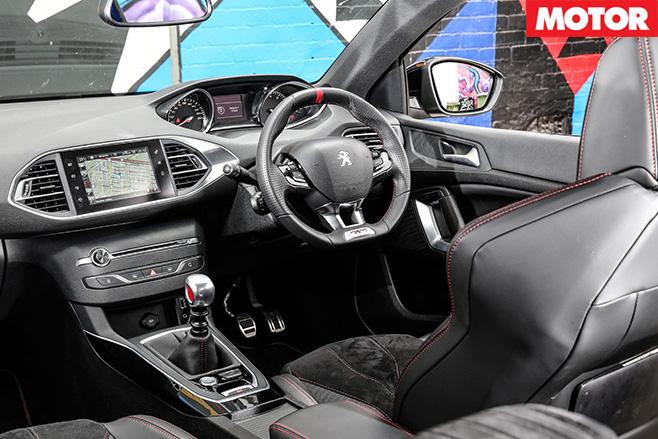
In the Megane you’ll strike a much more natural pose. Its hip point is well below the steering wheel which puts the wheel at chest height and instantly primes you for a punt, ready to take on a challenging road.
There’s a whiff of dullness around the steering’s centre, but it’s linear with sufficient feedback and is quick enough to keep up with the car’s hyper-alert chassis. Push on and it’s like the chassis has been welded to your nervous system, the driver able to sense the car’s every intention.
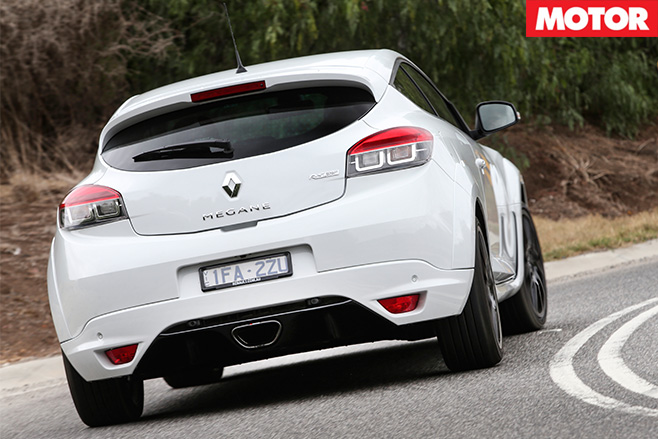
The high seating position and small wheel in your lap is much like the 208, while the 308’s firm suspension copies the sadly departed and fairly simmering RCZ-R (which finished fourth at PCOTY, remember). Similarly, the Torsen LSD is an evolution of the unit in the RCZ-R and, along with increased negative camber and wider tracks, works to increase front grip and bully the 235mm front Michelin Pilot Super Sports into corners.
Diff lock-up can be a little inconsistent and it feels like it can’t transfer the same amount of torque to the outside wheel as the Megane, but if the inside wheel has enough grip, it can pull through corners with serious speed. However, the steering’s indirectness means a little guesswork is needed, which makes it hard to nail every corner. It’ll bob over bumps and shimmy into corners but the suspension has a degree of compliance that sees it strike a decent balance between ride and handling.
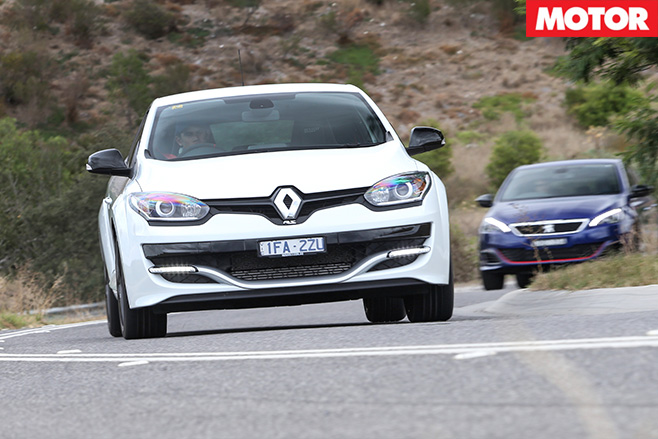
For noise the Megane’s titanium Akrapovic exhaust shames the Peugeot’s half-fake note, the Renault’s snarl accompanied by a cacophony of pops and bangs on the overrun. The Peugeot’s dual pipes make a decent tune with a blow-off-valve-like sneeze accompanying each lift of the throttle, but unfortunately to hear that you’ve got to have the windows down.
Between corners the Peugeot’s hard-working 200kW/330Nm 1.6-litre is a sweet, flexible thing that starts huffing as early as 2000rpm and loves to spin out in a smooth, elastic fashion. There’s some lag but that stems from the fact Peugeot stuffed it with Mahle pistons, trick bearings and 22psi of boost on 9.2:1 compression to help make up for its 400cc deficit.
In contrast, the Renault’s 201kW/360Nm 2.0-litre four-pot has more muscle. Once the needle passes 3000rpm the grunt comes on hard and fast in a manic rush; it’s a bit cruder in operation, winding up quickly and feeling deadliest in its mid-range, but it’s certainly no less potent.

The Peugeot finally lands a punch once the show is rolling. Its superior power-to-weight ratio (166kW/tonne plays 146kW/tonne) helps it eke out a 2.57km/h advantage in trap speed (ie, it’s chasing the Renault down) and it thrashes the Megane for sixth-gear overtaking punch, nailing 80-120km/h 2.3sec faster, though that gap shrinks to just 0.1sec in third.
As for stopping, you only have to peek behind the Peugeot’s enormous 19-inch wheels to see that braking was always going to be one of its strong points. The enormous 380mm two-piece front rotors even come with a warning not to be alarmed by race-car style noises under low speed operation due to brake dust build-up, something Peugeot is currently developing a fix for.
They feel over-assisted for the first few centimetres of pedal travel but with a firm press and once a bit warm they pull the 1205kg 308 to a halt from 100km/h in just 34.2m – a full 4.7m shorter than the Megane.
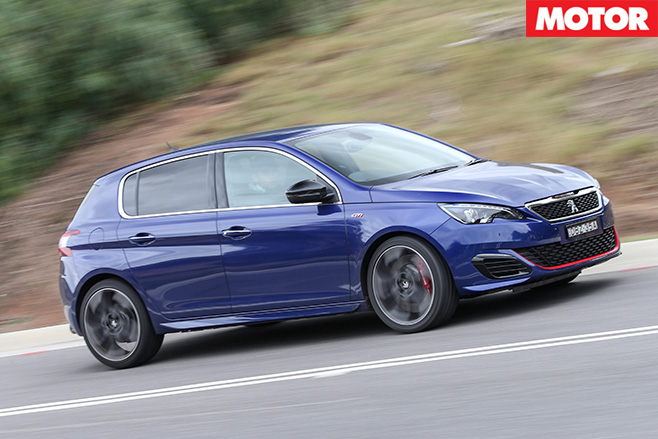
The two-door, subtly pumped body gives the Megane a more svelte shape but square-on there’s something off about the size of its headlights and badge. The platinum grey blade slotted into the front grille is a nice touch, but when are manufacturers going to stop with the fake exhaust tips?
Looks provide a compelling reason to pick the Renault and many diehards will rue the change to a five-door body when the new Megane RS arrives in 2017. Likewise the loss of one of the most bewitching front-drive chassis ever built, should the whispers that Renault is going Focus RS hunting with an all-wheel drive system prove true.
Not to mention the demise of the manual gearbox. All undoubtedly changes that should shift a lot more Renault Sport Meganes, but few cars provide such an adrenalin hit while also flattering your abilities as the current model – it’s a proper supercar hurry-upperer on the right road.
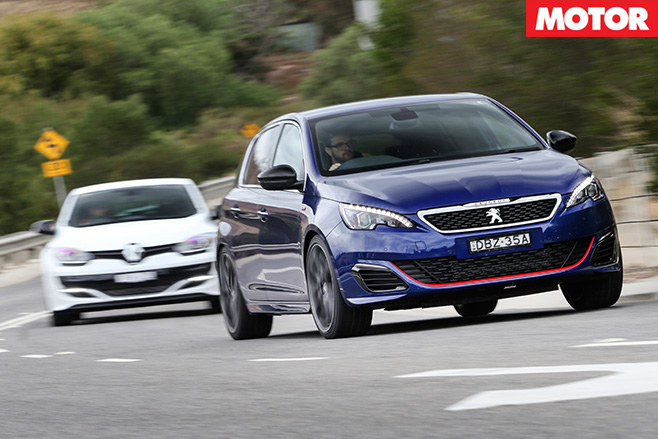
Including the Peugeot. The ride is more than bearable, the engine’s more tractable and the steering’s easier to use day-to-day. It’s seven years younger than its fellow Frenchie, so you’d expect its package to be more refined, but Peugeot has done so well chasing its German opposition that its cabin feels as hushed and solid as any.
Sure, the all-in-one media screen that hides the HVAC controls in a sub-menu can be a little… testing, it has the world’s most abrasive door-open warning chime and the fake engine note in sport mode at 100km/h sounds like somebody sat on a pipe organ, but it’s still a great drive and impressive value.
You might not exit the 308 GTi 270 in a dopamine-laced buzz like you do in the Megane, and it’s unlikely to be as quick around a circuit (we’ll find out at BFYB), but there’s enough performance up to at least eight-tenths that what’s lost to the Megane on a Sunday fang is made up for by the plusher cabin and cushier suspension on the other six days. There are further challenges ahead (VW’s new GTI Clubsport for one) but Peugeot’s new hottie has proved its potency.
The numbers
Front-paw fighters
| u00a0 | Peugeot 308 GTi 270 | Renault Megane RS275 |
| 0-10km/h | 0.52 | 0.41 |
| 0-20km/h | 1.03 | 0.92 |
| 0-30km/h | 1.5 | 1.38 |
| 0-40km/h | 1.99 | 1.84 |
| 0-50km/h | 2.57 | 2.29 |
| 0-60km/h | 3.34 | 2.98 |
| 0-70km/h | 3.82 | 3.58 |
| 0-80km/h | 4.41 | 4.24 |
| 0-90km/h | 5.06 | 4.92 |
| 0-100km/h | 6.09 | 5.93 |
| 0-110km/h | 6.95 | 6.92 |
| 0-120km/h | 7.87 | 7.88 |
| 0-130km/h | 8.94 | 8.98 |
| 0-140km/h | 10.43 | 10.57 |
| 0-150km/h | 11.78 | 12.02 |
| 0-160km/h | 13.23 | 13.57 |
0-400m | 14.16sec @ 165.57km/h | 14.09sec @ 163km/h |
SPEED IN GEARS | 54km/h @ 6500rpm | 59km/h @ 6500rpm |
2nd | 99km/h @ 6500rpm | 93km/h @ 6500rpm |
3rd | 132km/h @ 6500rpm | 130km/h @ 6500rpm |
4th | 172km/h @ 6500rpm | 176km/h @ 6500rpm |
5th | 215km/h @ 6500rpm | 222km/h @ 6500rpm |
6th | 235km/h @ 6000rpm* | 255km/h @ 6165rpm* |
As tested by MOTOR: Heathcote Dragway, 10:36am, 21 degrees, dry. Driver: Scott Newman. *Manufacturer’s claim
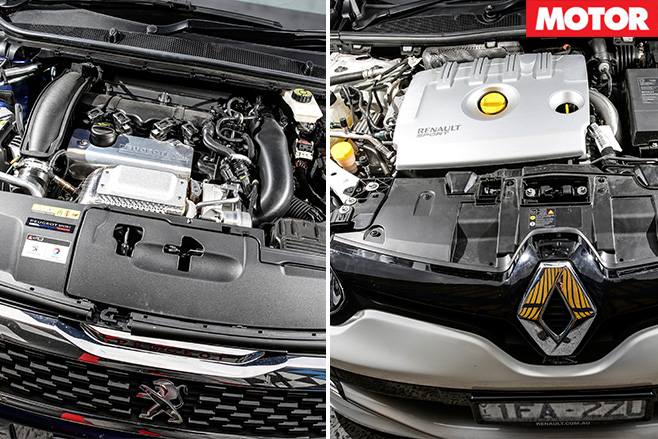
Specs
| u00a0 | Peugeot 308 GTi 270 | Renault Megane RS275 Cup |
| Body | 5-door, 5-seat hatch | 2-door, 4-seat coupe |
| Drive | front-wheel | front-wheel |
| Engine | 1598cc inline-4, DOHC, 16v, turbo | 1998cc inline-4, DOHC, 16v, turbo |
| Bore/Stroke | 77.0 x 85.8mm | 82.7 x 93.0mm |
| Compression | 9.2:1 | 8.6:1 |
| Power | 200kW @ 6000rpm | 201kW @ 5500rpm |
| Torque | 330Nm @ 1900-5500rpm | 360Nm @ 3000rpm |
| Power/Weight | 166kW/tonne | 146kW/tonne |
| Transmission | 6-speed manual | 6-speed manual |
| Weight | 1205kg | 1376kg |
| Suspension(F) | struts, coil springs, anti-roll baru00a0 | struts, coil springs, anti-roll bar |
| Suspension(R) | torsion beam, coil springs, anti-roll bar | torsion beam, coil springs, anti-roll bar |
| L/W/H | 4253/1804/1446mm | 4320/1848/1422mm |
| Wheelbase | 2620mm | 2646mmu00a0 |
| Tracks | 1570/1554mm (f/r)u00a0 | 1546/1547mm (f/r) |
| Steering | electrically-assisted rack-and-pinion | electrically-assisted rack-and-pinion |
| Brakes(F) | 380mm ventilated discs, four-piston calipers | 340mm ventilated discs, four-piston calipers |
| Brakes(R) | 268mm solid discs, single-piston calipers | 290mm solid discs, single-piston calipers |
| Wheels | 19 x 9.0-inch (f/r) | 19 x 8.25-inch (f/r) |
| Tyre sizes | 235/35 R19 91Y (f/r)u00a0 | 235/35 ZR19 (f/r)u00a0 |
| Tyre | Michelin Pilot Super Sport 3 | Bridgestone Potenza RE050Au00a0 |
| Price as tested | u00a0$49,990u00a0 | $53,000u00a0 |
| Pros | Great ride/handling mix; superb engine; nicer interior | Still the pinnacle of front-drive performance |
| Cons | Lacking steering feel; driving position; fake engine note | Firm ride; could be trying as a daily driver |
| Star Rating | 4/5 | 4/5 |


